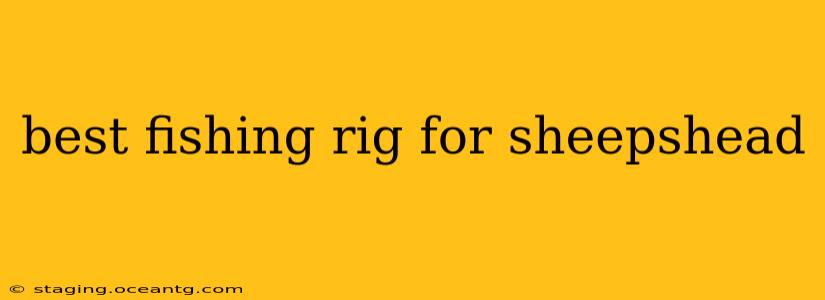Sheepshead, with their tough mouths and discerning palates, present a unique challenge to anglers. Landing one requires more than just luck; it demands the right gear. This guide dives deep into selecting the best fishing rig for sheepshead, ensuring you're equipped for success on your next fishing trip. We'll cover everything from line and hooks to weights and techniques, answering many common questions anglers have.
What is the Best Bait for Sheepshead?
Sheepshead are known for their picky eating habits. While they'll occasionally take artificial lures, live bait generally produces the best results. Fiddler crabs are a classic and highly effective choice. Their natural movement and scent are irresistible to sheepshead. Other excellent options include live shrimp, sand fleas, and even small pieces of clam or oyster. The key is to present the bait naturally and convincingly.
What Kind of Hook is Best for Sheepshead?
Sheepshead possess remarkably strong jaws and teeth. Therefore, choosing the right hook is crucial for preventing breakoffs. A circle hook is widely considered the best option for sheepshead fishing. Its design minimizes gut-hooking, making it more humane and increasing your chances of landing the fish. Sizes ranging from 1/0 to 3/0 are typically suitable, depending on the size of your bait and the sheepshead you're targeting. Make sure the hook is strong enough to withstand the powerful pull of a large sheepshead.
What Line Should I Use for Sheepshead?
The line you choose should be strong enough to handle the sheepshead's powerful pull but also sensitive enough to detect subtle bites. A braided line with a test strength of 15-20 pounds is an excellent choice. Braided line offers superior sensitivity and strength compared to monofilament. However, you might consider using a fluorocarbon leader (around 6-12 pounds test) of about 2-3 feet in length. This helps to camouflage your line, making it less visible to the wary sheepshead.
What Weight Should I Use When Fishing for Sheepshead?
The weight you need will depend heavily on the current and the depth of the water you're fishing in. Generally, a 1-2 ounce weight is a good starting point. You can adjust this based on the conditions. If the current is strong, you'll need a heavier weight to keep your bait on the bottom. If the current is weak or you are fishing in shallow water, a lighter weight will suffice. A sliding weight rig is often preferred to allow for better presentation of the bait.
What Type of Rig is Best for Sheepshead?
While various rigs can be effective, a simple Carolina rig or a fish-finder rig are popular choices among sheepshead anglers. These rigs allow for a natural presentation of your bait, keeping it close to the structure where sheepshead like to feed. The Carolina rig, in particular, allows the bait to move more freely, enticing bites. A simple bottom rig with a weight, swivel, and leader can also be very effective.
What is the Best Time of Year to Catch Sheepshead?
Sheepshead are most active during the warmer months, typically from spring through fall. However, you can still catch them throughout the year, depending on your location and the water temperature.
What is the Best Location to Catch Sheepshead?
Sheepshead are structure-oriented fish. They love to inhabit areas with plenty of cover, such as jetties, docks, piers, bridges, and artificial reefs. Look for areas with rocks, pilings, or other hard structures where they can find food and shelter.
How Do I Fish for Sheepshead from a Pier?
Fishing for sheepshead from a pier requires a similar approach to other locations. Focus on areas near pilings or where structure is abundant. Use the appropriate rig and bait, and remember to present your bait naturally.
By employing these tips and understanding the nuances of sheepshead behavior, you'll significantly improve your chances of landing these challenging yet rewarding fish. Remember, practice and patience are key to mastering the art of sheepshead fishing.
